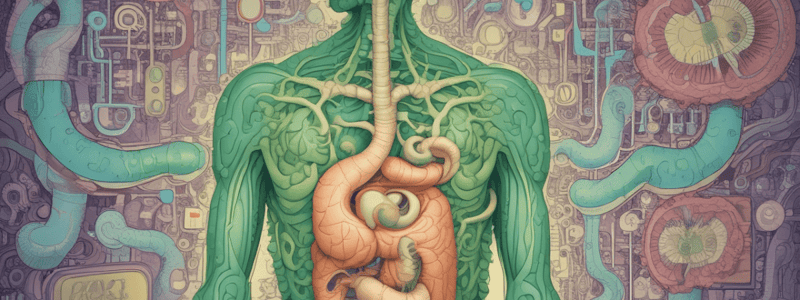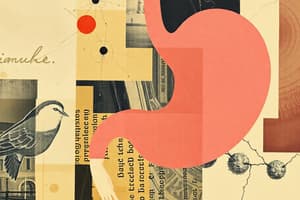Podcast
Questions and Answers
What is the function of the mucosa layer in the digestive tract?
What is the function of the mucosa layer in the digestive tract?
- To protect the digestive tract from mechanical stress
- To secrete mucus, hormones, and enzymes into the lumen GI (correct)
- To produce enzymes and acids for digestion
- To absorb digested nutrients into the bloodstream
What is the function of the muscularis externa layer in the digestive tract?
What is the function of the muscularis externa layer in the digestive tract?
- To mix and churn food in the digestive tract
- To absorb digested nutrients into the bloodstream
- To control the movement of food through the digestive tract (correct)
- To produce hormones and enzymes for digestion
What is the main function of the epithelial cells in the mucosa layer?
What is the main function of the epithelial cells in the mucosa layer?
- To protect the digestive tract from bacteria
- To produce stomach acid
- To absorb digested nutrients into the bloodstream
- To secrete mucus, hormones, and enzymes into the lumen GI (correct)
What is the function of the serosa layer in the digestive tract?
What is the function of the serosa layer in the digestive tract?
What is the main function of the submucosa layer in the digestive tract?
What is the main function of the submucosa layer in the digestive tract?
What controls the digestive function in the gastrointestinal tract?
What controls the digestive function in the gastrointestinal tract?
What is the primary function of the mucus neck cells in the stomach?
What is the primary function of the mucus neck cells in the stomach?
What is the role of histamine in gastric acid secretion?
What is the role of histamine in gastric acid secretion?
What is the primary site of vitamin B12 absorption?
What is the primary site of vitamin B12 absorption?
What stimulates the release of gastrin releasing peptide (GRP) in the stomach?
What stimulates the release of gastrin releasing peptide (GRP) in the stomach?
What is the primary function of chief cells in the stomach?
What is the primary function of chief cells in the stomach?
What is the role of somatostatin in gastric secretion?
What is the role of somatostatin in gastric secretion?
What is the primary mechanism by which gastric acid secretion is terminated after a meal?
What is the primary mechanism by which gastric acid secretion is terminated after a meal?
What is the primary component of the mucus barrier that protects the stomach lining from acid and enzymes?
What is the primary component of the mucus barrier that protects the stomach lining from acid and enzymes?
What is the primary function of HCl in the stomach?
What is the primary function of HCl in the stomach?
What is the main mechanism of mucus barrier function in the stomach?
What is the main mechanism of mucus barrier function in the stomach?
Which of the following is NOT a function of HCl in the stomach?
Which of the following is NOT a function of HCl in the stomach?
What is the primary cause of gastric ulcer formation?
What is the primary cause of gastric ulcer formation?
What is the primary route of Helicobacter pylori transmission?
What is the primary route of Helicobacter pylori transmission?
Why is nutrient absorption not possible in the stomach?
Why is nutrient absorption not possible in the stomach?
Flashcards are hidden until you start studying
Study Notes
Functions of HCl
- Breaks down food particles and forms a molecular solution called chyme
- Denatures proteins and inactivates enzymes in food
- Activates pepsin
- Kills microorganisms in food
- Stimulates secretion of bile and pancreatic juice
Regulation of HCl Secretion
- HCl secretion is regulated by the nervous system and hormonal system
- The cephalic phase is activated by vagal input, releasing gastrin-releasing peptide (GRP) and acetylcholine (ACh)
- The gastric phase is stimulated by the presence of food in the stomach, stretching the stomach wall and activating stretch receptors
- Somatostatin secretion is inhibited by the presence of food in the stomach, terminating gastric secretion
Mucosal Barrier
- The mucosal barrier is formed by mucus and bicarbonate secreted by the mucosa and tight junctions between mucosal cells
- It protects the mucosal cells from damage by HCl and pepsin
- Factors that damage the mucosal barrier include ethanol, acetic acid, aspirin, non-steroidal anti-inflammatory drugs (NSAIDs), and bile salts
- Mucus secretion is stimulated by irritation of the mucosa, vagus nerve, and prostaglandins
Peptic Ulcers
- Peptic ulcers are caused by Helicobacter pylori infection, which colonizes the antrum of the stomach
- H. pylori has 4-6 flagella and produces urease, which breaks down urea into ammonia, acting as a buffer
- H. pylori infection is commonly found in people with poor sanitation and hygiene
Absorption in the Stomach
- Absorption does not occur in the stomach due to the presence of mucus and the lack of transport mechanisms in epithelial cells
- The stomach contents are churned and fragmented by segmentation, mixing with intestinal secretions
Layers of the Digestive Tract Wall
- Mucosa: epithelial cells, lamina propria, and muscularis mucosa
- Submucosa: loose connective tissue with blood vessels, nerves, and lymphatic vessels
- Muscularis externa: circular and longitudinal muscle layers
- Serosa: mesothelial cells secreting serous fluid to reduce friction between organs
Histology of the Alimentary Canal
- The mucosa has epithelial cells, glands, and lamina propria
- The submucosa has loose connective tissue with blood vessels, nerves, and lymphatic vessels
- The muscularis externa has circular and longitudinal muscle layers
- The serosa has mesothelial cells secreting serous fluid
Control of Digestive Function
- Digestive function is controlled by the nervous system and hormonal system
- The digestive system responds to the volume and composition of the luminal contents
- Secretion of digestive enzymes and hormone regulation is controlled by the nervous system and hormonal system
Studying That Suits You
Use AI to generate personalized quizzes and flashcards to suit your learning preferences.



